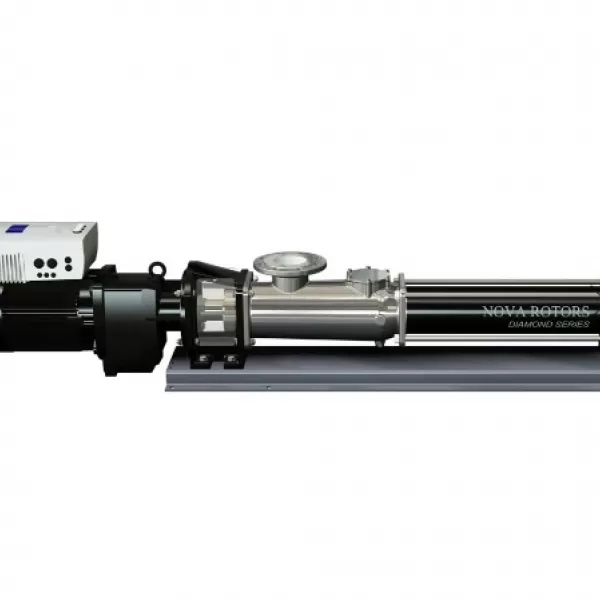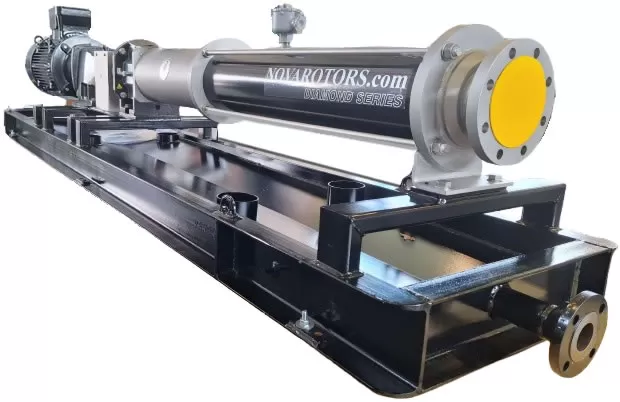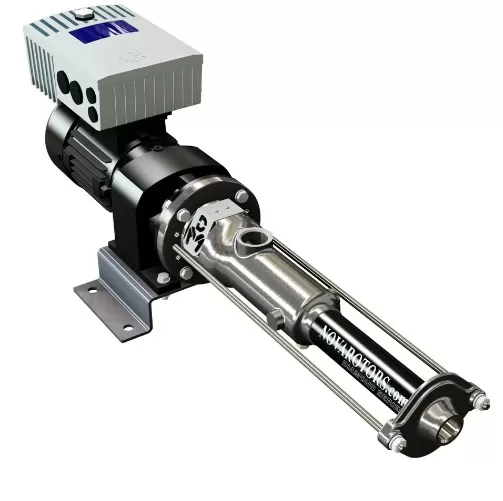ATEX pumps: comprehensive guide to safety and compliance in explosive environments

Atex pumps: introduction to safety in potentially explosive environments
In the modern industrial landscape, operational safety is an absolute priority, especially when working in environments with potentially explosive atmospheres. ATEX pumps certified according to European regulations are a fundamental element to ensure safe and efficient operations in the chemical sector, chemical industry, and offshore platforms.
Nova Rotors stands out as a leader in the design and manufacture of pumps for offshore platforms and chemical plants, offering certified solutions that comply with the most stringent international safety standards. Our decades-long experience in producing pumping systems for ATEX environments ensures maximum operational reliability even in the most critical conditions.
ATEX regulation: principles and compliance requirements
History and evolution of the ATEX directive
The ATEX Directive (ATmosphères EXplosibles) 2014/34/EU sets out the essential safety requirements for equipment intended for use in potentially explosive atmospheres. This regulation, which evolved from the previous 94/9/EC, is the key regulatory reference for all operators who design, produce, and use equipment in explosion-risk environments.
The implementation of the ATEX regulation has revolutionised the approach to industrial safety, introducing design, certification, and marking criteria that ensure the prevention of explosions caused by electrical and mechanical equipment.
Classification of hazardous zones
Proper identification and classification of hazardous zones is the fundamental prerequisite for selecting the appropriate chemical sector pumps:
Zone 0 (Gas): Area in which an explosive atmosphere consisting of a mixture of air and flammable substances in the form of gas, vapour, or mist is present continuously or for long periods.
Zone 1 (Gas): Area in which, during normal operation, the formation of an explosive atmosphere consisting of a mixture of air and flammable substances in the form of gas, vapour, or mist is likely to occur occasionally.
Zone 2 (Gas): Area in which, during normal operation, the formation of an explosive atmosphere consisting of a mixture of air and flammable substances in the form of gas, vapour, or mist is not likely to occur, and if it does, it will only persist for a short period.
Zones 20, 21, 22 (Dust): Similar classifications for environments with the presence of combustible dust, with decreasing levels of risk.
Equipment groups and categories
Nova Rotors ATEX pumps are classified according to strict criteria:
Group I: Equipment for mines with firedamp (methane) presence.
Group II: Equipment for surface industries, divided into:
- Category 2G: Zone 1 – "High" level of protection
- Category 3G: Zone 2 – "Normal" level of protection
ATEX pump protection technologies
Ignition prevention protection
Nova Rotors implements various protection technologies in its chemical industry pumps:
Intrinsic safety (ia/ib): Limiting electrical and thermal energy to levels incapable of causing ignition. This technique is particularly effective for control systems and instrumentation associated with the pumps.
Flameproof protection (d): Containing any explosions within the enclosure to prevent propagation to the surrounding atmosphere. The enclosures are designed to withstand the pressure of internal explosions.
Pressurised protection (p): Maintaining an internal pressure higher than the ambient pressure using an inert protective gas, preventing the ingress of explosive atmospheres.
Encapsulation (m): Embedding electrical components in compounds that prevent the ignition of surrounding explosive atmospheres.
Specific mechanical protections
Antistatic construction: Use of materials and surface finishes that prevent the accumulation of electrostatic charges, a potential ignition source.
Surface temperature limitation: Strict control of operating temperatures to ensure that no surface exceeds the auto-ignition temperature of the handled fluids.
Safe lubrication systems: Implementation of lubrication systems that prevent overheating of bearings and rotating parts.

Design and construction of Nova Rotors ATEX pumps
Safety-oriented design philosophy
The design of Nova Rotors offshore platform pumps follows a holistic approach that integrates safety, reliability, and performance:
Comprehensive risk analysis: Systematic evaluation of all potential hazard scenarios, from initial design through to equipment decommissioning.
Fail-safe design: Implementation of systems that, in the event of failure, evolve towards intrinsically safe conditions.
Redundancy of critical systems: Duplication of safety systems to ensure operational continuity even in the presence of single failures.
Advanced materials and construction technologies
Special corrosion-resistant alloys: Use of duplex and superduplex stainless steels to ensure resistance in chemically aggressive environments.
Advanced protective coatings: Application of ceramic and polymer coatings to increase wear and corrosion resistance.
Certified mechanical seals: Implementation of sealing systems specifically designed for ATEX environments, with double barriers and monitoring systems.
Integrated monitoring and control systems
Multiple safety sensors: Continuous monitoring of temperature, pressure, and gas presence for early anomaly detection.
Automatic shutdown systems: Implementation of safety logic that automatically stops the pump under hazardous conditions.
Secure interfaces: Integration with distributed control systems using communication protocols certified for ATEX environments.
Sector applications
Petrochemical industry and refineries
In the chemical oil sector, Nova Rotors ATEX pumps handle the transfer of crude oil, petroleum processing residues, light hydrocarbons, gasoline, diesel, and intermediate refining products. The presence of flammable vapours requires pumping systems certified for Zones 1 and 2.
Chemical and pharmaceutical industry
Chemical industry pumps are critically used for handling solvents, acids, volatile organic compounds, and synthesis intermediates. The variety of chemical substances requires customised solutions for each specific application.
Offshore oil platforms
Offshore platform pumps operate in extremely challenging conditions, with hydrocarbons, saline environments, and adverse weather. ATEX certification becomes crucial for personnel safety and environmental protection.
Food and beverage industry
Even in the food sector, the presence of extraction solvents, alcohols, and fuels requires the use of ATEX-certified pumps to ensure production process safety.
Installation and commissioning in ATEX environments
Certified installation procedures
The installation of ATEX pumps requires specialist expertise and adherence to strict procedures:
Preliminary site analysis: Detailed assessment of environmental conditions, zone classification, and identification of potential risks.
Layout design: Optimisation of positioning to minimise exposure to ignition sources and facilitate maintenance operations.
Pre-commissioning checks: Thorough testing of all safety systems before putting into operational service.
Documentation and traceability
Certificates of conformity: Each pump is accompanied by complete certification issued by European notified bodies.
Specific operating manuals: Detailed documentation for operation, maintenance, and troubleshooting in ATEX environments.
Change log: Complete traceability of any modification or update to maintain certification validity.
Maintenance and lifecycle management
Maintenance strategies in ATEX environments
Maintenance of chemical sector pumps in ATEX environments requires specialised approaches:
Advanced predictive maintenance: Use of ATEX-certified sensors for continuous monitoring of operating conditions and failure prediction.
Qualified personnel: Specialist training of maintenance staff on the specific risks of ATEX environments.
Operational best practices
Scheduled inspections: Definition of inspection schedules based on risk level and operational experience.
Spare parts management: Maintaining stocks of certified spare parts to minimise plant downtime.
Regulatory updates: Continuous monitoring of regulatory developments to ensure permanent compliance.
Specialised after-sales services
Nova Rotors offers comprehensive services for managing the lifecycle of ATEX pumps:
Specialised maintenance contracts: Service packages including preventive, predictive, and emergency maintenance.
Technological upgrades: Possibility of upgrades to keep pumps aligned with technological and regulatory developments.
Technical support: Continuous assistance for emergency situations and operational support.

Technological innovations and future developments
Digitalisation and industry 4.0 in ATEX environments
The evolution towards Industry 4.0 presents unique challenges for ATEX environments:
Certified smart sensors: Development of advanced monitoring systems with self-diagnosis capabilities and secure wireless communication.
Digital twins for explosive environments: Creation of virtual models that simulate pump behaviour under ATEX conditions to optimise maintenance and performance.
Artificial intelligence for safety: Implementation of machine learning algorithms to predict and prevent hazardous situations.
Advanced materials and sustainability
Innovative alloys: Research into materials with superior corrosion resistance and anti-spark safety performance.
Energy efficiency: Development of high-efficiency ATEX-certified motors and control systems to reduce environmental impact.
Circular economy: Design focused on material recovery and reuse to minimise environmental impact.
International standards and certifications
Global regulatory overview
Beyond the European ATEX directive, the motors of offshore platform pumps often need to comply with international standards:
IECEx: International certification system for equipment used in explosive atmospheres.
NEC (National Electrical Code): US standard for electrical installations in classified areas.
CSA (Canadian Standards Association): Canadian regulations for explosive environments.
Nova Rotors certification process
Certified design: Every project is developed following applicable regulatory requirements from the earliest stages.
Compliance testing: In-depth testing at accredited laboratories to verify compliance with all regulatory requirements.
Quality audits: Periodic inspections of the quality system by independent certification bodies.
Economic analysis and return on investment
Total Cost of Ownership in ATEX environments
Investment in certified ATEX pumps should be evaluated considering:
Compliance costs: Savings from avoiding penalties and operational interruptions due to non-compliance.
Insurance costs: Reduced insurance premiums thanks to the use of certified equipment.
Avoided incident costs: Economic value of preventing potentially catastrophic incidents.
Comparative benefit analysis
Comparison with non-certified solutions: Demonstrating the economic and legal risks of using non-compliant equipment.
Operational risk assessment: Quantifying the benefits from reducing explosion risk.
Process optimisation: Efficiency improvements achievable through the use of advanced certified technologies.
Optimal selection and configuration
Selection criteria for ATEX environments
Choosing the most appropriate chemical industry pumps requires analysis of specific parameters:
Zone classification: Selecting the appropriate category based on the installation area's classification.
Fluid characteristics: Assessing compatibility with certified materials and auto-ignition temperature.
Operating parameters: Defining flow rate, head, and operating conditions within safety limits.
Process requirements: Integration with existing control and safety systems.
Custom configurations
Nova Rotors develops tailored solutions for every application:
In-depth engineering analysis: Detailed study of operating conditions and specific requirements.
Advanced CFD simulations: Design optimisation through computational fluid dynamics simulations.
Prototyping and testing: Validation of solutions through prototype testing before serial production.
ATEX pumps: safety and performance without compromise
Nova Rotors ATEX pumps represent technological excellence in handling fluids in potentially explosive environments. The combination of advanced design, certified materials, and integrated safety systems ensures safe and efficient operations even under the most critical conditions.
Investing in ATEX-certified technologies is not just a cost for regulatory compliance, but a strategic choice that generates value through:
- Maximum operational safety for personnel and facilities
- Guaranteed regulatory compliance at European and international levels
- Superior operational reliability with reduced plant downtime
- Optimised energy efficiency for environmental sustainability
- Specialised technical support throughout the lifecycle
Nova Rotors technology continues to evolve to anticipate future market needs, integrating digital innovations and sustainable solutions without ever compromising operational safety.
For expert advice on selecting and implementing ATEX pumps, the Nova Rotors technical team is available for in-depth analyses and customised solutions for every specific industrial requirement.
Safety in explosive environments allows no compromises: choose Nova Rotors certified excellence and contact us for more information!